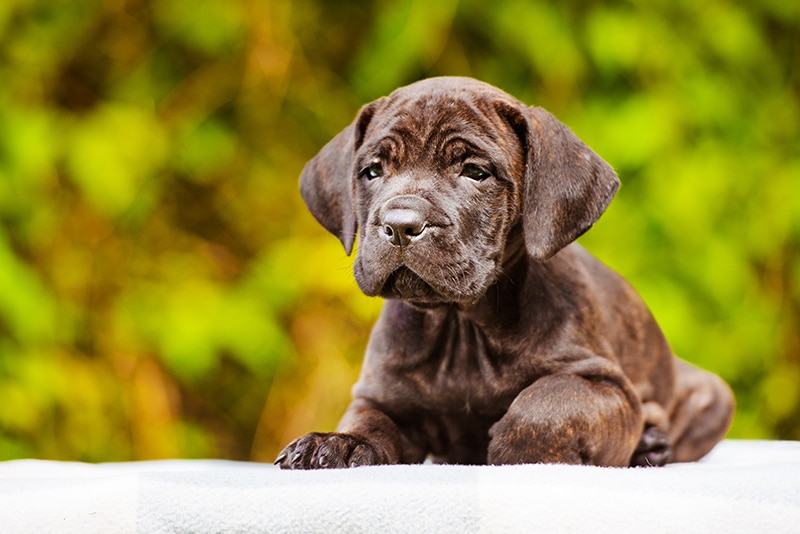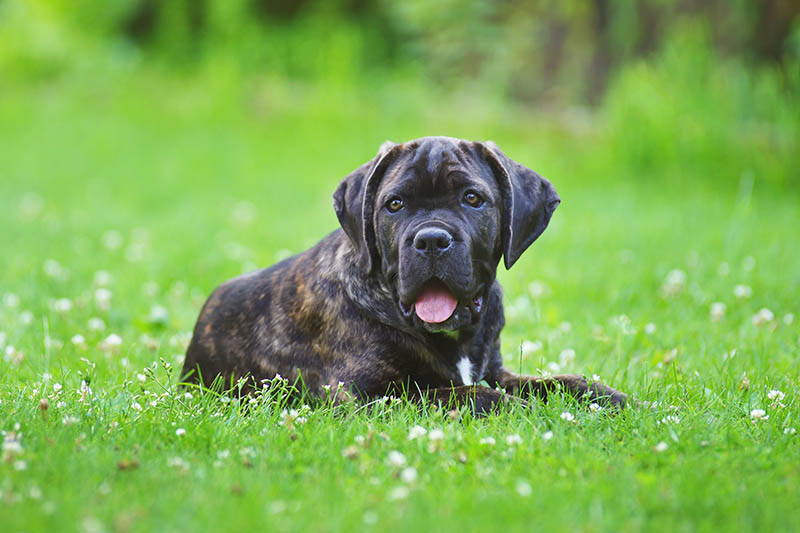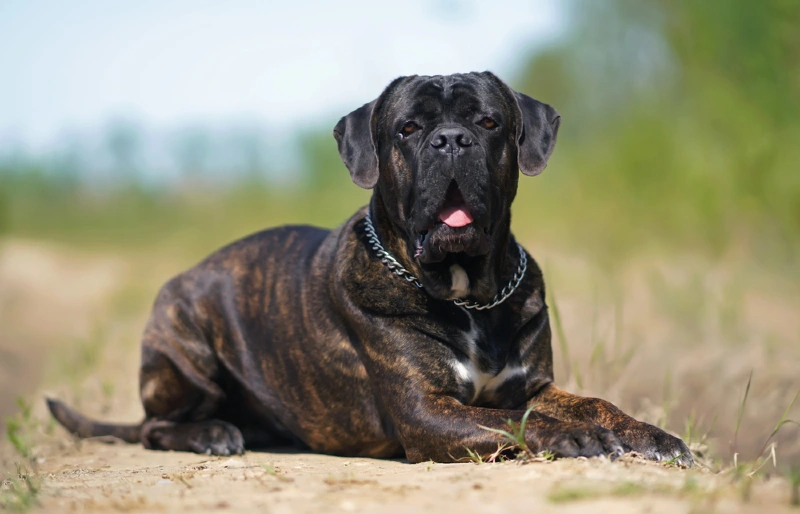Click to Skip Ahead
The Brindle Cane Corso is not actually a breed separate from the Cane Corso but is instead one of the many coat patterns and colorations officially recognized for the breed. Brindle refers to a coat pattern similar to tiger stripes, though much more subtle and blended than traditional stripes.
Keep reading to learn more about this beautiful dog’s fascinating history and what makes its coloration so unique.
Breed Overview
Height:
23.5–27.5 inches
Weight:
90–110 pounds
Lifespan:
9–12 years
Colors:
Black brindle, gray brindle, chestnut brindle
Suitable for:
Experienced dog owners with a lot of time to put toward training and socialization
Temperament:
Fiercely loyal, highly intelligent, easy to train, territorial, high prey drive
The Cane Corso is recognized in three brindle colorations: black, gray, and chestnut. Black is the most common style for Cane Corsi, with alternating stripes between black and lighter brown. Gray brindles, sometimes mistakenly called blue brindles, are rarer as they need a recessive dilution gene to achieve this coloration.
Finally, chestnut brindles are the rarest Cane Corso color combination. Those with this coloration appear lighter in color, almost like a fawn brown.
Brindle Cane Corso Breed Characteristics

The Earliest Records of Brindle Cane Corso in History
Cane Corso dogs descended from now-extinct Greek Molossian war dogs present in ancient Rome. After the Romans invaded the Greek islands, they brought some of the dogs back to Italy, eventually breeding them with native Italian dog breeds. The two breeds that were created from this breeding period include the Cane Corso and its bigger relative, the Neapolitan Mastiff.
Ancient Cane Corsi were larger and more lumbering than their current-day counterparts. They made their mark on the work as a fearless Roman war dog, unafraid of charging enemy lines or protective Roman soldiers.
The two World Wars all but decimated the breed in Italy as their working needs weren’t in high demand. As a result, cane Corso dogs stayed rare until the 1970s, when selective breeding needed to occur to revive the breed. After this point, the Cane Corso was finally introduced to the United States.

How Brindle Cane Corso Gained Popularity
Despite almost becoming extinct during World Wars I and II, the Cane Corso prevailed. Several dogs still existed in the post-war world, and Italian Cane Corso enthusiasts used these resilient pups to revive the breed. However, the first dogs didn’t arrive in America until 1988. It was after this they were formally accepted as a breed throughout many kennel clubs worldwide.
Cane Corsi are so popular because they’re natural guardians, intuitive, and protective of their family members. They bond closely with their humans and can be gentle and tolerant of children. Cane Corso dogs look tough because of their history as war dogs, but with proper training and socialization, they make fantastic family pets with unparalleled devotion and sensitivity.
Formal Recognition of Brindle Cane Corso
The Ente Nazionale della Cinofilia Italiana (ENCI), also known as the Italian Kennel Club, recognized Cane Corso dogs in 1994. They were provisionally accepted by the Fédération Cynologique Internationale (FCI), the largest international federation of national kennel clubs, in 1996. The FCI officially fully accepted the breed in 2007. In addition, the United Kennel Club recognized the breed in 2008.
The Cane Corso was not officially recognized as a breed by the American Kennel Club until 2010. This may be because they weren’t really introduced to the United States until the 1980s.
Top 3 Unique Facts About Brindle Cane Corso
1. Brindle Cane Corso Dogs Live Longer
A study from the Czech Republic found that the color of a Cane Corso can play a part in the dog’s lifespan1. Researchers found that the longest-lived Cane Corso dogs had a black brindle coloration (10.3 years). They were closely followed by other brindle-patterned pups, including plain brindles (10.13 years) and grey brindles (9.84 years).
Researchers from another similar study regarding Labrador Retrievers suggest that the relationship between coat color and disease can result from breeding certain color pigmentations.
When it comes to Labs, for example, those with chocolate coloring were more likely to get ear inflammation and certain kinds of dermatitis. The chocolate coloration is recessive, so it must be present in both parents to create chocolate-colored pups. This leads to a reduced gene pool for chocolate dogs which may mean there is a higher proportion of genes that cause ear and skin conditions.
2. “Cane Corso” Means “Bodyguard Dog”
This breed name loosely translates to “bodyguard dog” or “guard dog of the courtyard.” This shouldn’t be a surprise, as the breed certainly lives up to its name. The early Cane Corso pups would accompany soldiers into battle, serving as additional support to the military men and women.
3. Many Celebrities Enjoy the Companionship of Cane Corso Dogs
There was once a time when purse-sized dogs were all the rage in Hollywood (we’re looking at you, circa 2003 Paris Hilton). But many celebs are bucking that pint-size pup trend, opting instead for large and in-charge breeds like the Cane Corso.
Some celebrities choosing the companionship of a Cane Corso dog include Vin Diesel, Gillian Anderson, Tracy Morgan, Quentin Tarantino, Megan Thee Stallion, and Sherri Shepherd.


Does a Brindle Cane Corso Make a Good Pet?
A Brindle Cane Corso can make a great pet for the right family. However, this breed isn’t ideal for the beginner dog owner as it needs someone confident and assertive. These large dogs live in a social hierarchy where you must be the pack leader. If you do not assume this role, your dog will, leading to unpleasant consequences for the owner.
Cane Corsi are fantastic watchdogs and extremely loyal if you can get past that. They are affectionate and love deeply. These intelligent dogs are eager to please and confident. They must undergo rigorous training and socialization to avoid becoming aggressive and territorial.
In Conclusion
The Brindle Cane Corso is a beautiful dog with several coloration options, including black, chestnut, and gray. The breed has many redeeming characteristics, including its fierce loyalty and sensitivity. It has a rich history dating back to the Roman empire, but the modern-day version is still very new to the scene, at least by the AKC standards.
This breed can make a great pet for the right family, but it is best suited for people familiar with dog training rather than a first-time owner.
Featured Image Credit: Eudyptula, Shutterstock










